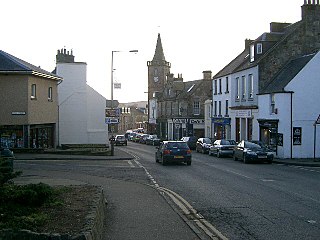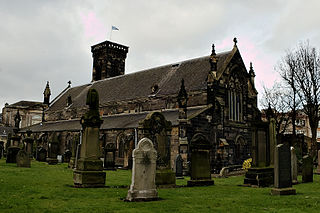
Michael Bruce was a Scottish poet and hymnist.

Kinross is a burgh in Perth and Kinross, Scotland, around 13 miles south of Perth and around 20 miles northwest of Edinburgh. It is the traditional county town of the historic county of Kinross-shire.

The County of Kinross or Kinross-shire is a historic county and registration county in eastern Scotland, administered as part of Perth and Kinross since 1975. Surrounding its largest settlement and county town of Kinross, the county borders Perthshire to the north and Fife to the east, south and west.

Milnathort is a small town in the parish of Orwell in the county of Kinross-shire, Scotland and since 1996, the local council area of Perth and Kinross. The smaller neighbour of nearby Kinross, Milnathort has a population of around 2,000 people. It is situated amidst countryside at the foot of the Ochil Hills, and near the north shore of Loch Leven. From 1977 it became more easily accessible due to the development of the M90 motorway. The name comes from the Gaelic maol coirthe meaning "bare hill of the standing stones".

Falkland, previously in the Lands of Kilgour, is a village, parish and former royal burgh in Fife, Scotland, at the foot of the Lomond Hills. According to the 2008 population estimate, it has a population of 1,180.
Saint Monan was a Christian missionary in Fife, probably a Gael. Little is known of him. Monan is believed to have lived at a monastery at Pittenweem before leaving to take up residence in a small cave at Inverey.

Markinch (, is both a village and a parish in the heart of Fife, Scotland. According to an estimate taken in 2008, the village has a population of 2,420. The civil parish had a population of 16,530. Markinch is east of Fife's administrative centre, Glenrothes and preceded Cupar as Fife's place of warranty and justice prior to the 13th century.

The Lomond Hills, also known outside the locality as the Paps of Fife, are a range of hills in central Scotland. They lie in western central Fife and Perth and Kinross, Scotland. At 522 metres (1,713 ft) West Lomond is the highest point in the county of Fife.

Kinnesswood, possibly from the Scottish Gaelic: Ceann eas ciad is a village in Perth and Kinross, Scotland, and is in the historic county of Kinross-shire. It lies to the east of Loch Leven, on the A911 road, below Bishop Hill in the Lomond Hills. It is approximately 4 miles west of Glenrothes and 4 miles east of Kinross.
Angus Morrison, is a minister of the Church of Scotland who was Moderator of the General Assembly of the Church of Scotland 2015–2016. He had been nominated for the role a year earlier but withdrew because of ill health. He is an Extra Chaplain to the King in Scotland, appointed in 2023.

Orwell is a parish in Kinross-shire, Scotland. It contains the market town of Milnathort, as well as the hamlet of Middleton. The name comes from the Gaelic iubhar coille meaning "yew wood".

Largoward is a village in East Fife, Scotland, lying on the road from Leven to St Andrews in the Riggin o Fife, 4½ miles north-east of Lower Largo and 6½ miles south-west of St Andrews. It is an agricultural and former mining village, one of the three main villages of the civil parish of Kilconquhar, along with Colinsburgh and the village of Kilconquhar. Coal must have been worked for a considerable length of time in the district, as it is recorded that coal was driven annually from Falfield, just north-west of the village, to Falkland Palace for the use of King James VI.

Cleish is a rural hamlet off the B9097 between Crook of Devon and the M90 motorway, three miles south-west of Kinross in central Scotland. It lies in the historic county of Kinross-shire.
Thomas Mair was a Scottish Anti-Burgher minister and moderator of the Anti-Burgher Associate Synod.

James Grant FRSE DD DCL was a Scottish minister. Combining his religious skills with business skills he was also Director of Scottish Widows for 50 years and Moderator of the General Assembly of the Church of Scotland in 1854. During his period as Moderator he was styled as Right Rev James Grant and thereafter as Very Rev James Grant.

John Laird (1811–1896) was a Scottish minister of the Free Church of Scotland who served as Moderator of the General Assembly to the Free Church 1889/90.
George Hamilton of Cairns (1635–1712) was a Church of Scotland minister who served as Moderator of the General Assembly in 1699.

David Arnot(t) (1803–1877) was a Scottish minister of the Church of Scotland who served as minister of St Giles Cathedral. He was also a noted religious author, poet, painter, sculptor and a gifted musician.
Andrew Grant (1757–1836) was a senior Scottish minister in the 19th century who became Chaplain in Ordinary to King George III, George IV and William IV in Scotland and Dean of the Chapel Royal. He was Moderator of the General Assembly of the Church of Scotland in 1808.
















